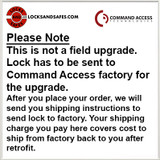
Command Access
Command Access Electric Upgrade For Mechanical Arrow QL82, LSDA C5400, Marks 195F Cylindrical Locks
Don't see the quantity, finish, or function you are looking for? We can mix, match and "BUILD" the item option set you are looking for - Just call us at 860-537-1328 and our sales staff will assist !

Command Access Electric Upgrade For Mechanical Arrow QL82, LSDA C5400, Marks 195F Cylindrical Locks
The Command Access electrified version of most Grade 1 lever lock lines allow for remote keyless access and egress control for heavy use applications where security and safety is critical. Common applications include stairwell doors, lobby entrances, computer rooms, classrooms, interior and exterior doors.
MODELS AVAILABLE
storeroom: (fail safe) - Outside lever locked (EL) electronically. Latchbolt retracted by key outside or lever inside. Switched power allows outside lever to retract latchbolt. Inside lever is always free for immediate egress.
storeroom: (fail secure) - Outside lever unlocked (EU) electronically. Latchbolt retracted by key outside or lever inside. Switched power allows outside lever to retract latchbolt. Inside lever is always free for immediate egress.
Note
Fail Safe - Electrically Locked (EL): Fail safe products are unlocked when power is removed. Power is applied to lock the door.
Fail Secure - Electrically Unlocked (EU): Fail secure products are locked when power is removed. Power is applied to unlock the door.
FEATURES
• Continuous duty solenoids allow for “continuously on” applications such as Fail Safe or an unlock cycle
• Plug-in bridge rectifier that allows for an AC or DC power source
• No hassle 3-Year Warranty
SPECIFICATIONS
• Operating Voltage - 12 or 24VAC/DC (+or- 10%) (must specify 12 or 24 volts when ordering)
• Amperage - 12V = 250 mA / 24V = 150 mA
• Solenoid coil resistance - 12V = 49 Ω / 24V = 159 Ω
• Power consumption - 3 watts
- Option:Choose REX Switch Option (What is a REX Switch Option? Click here to know more):
- https://blog.locksandsafes.com/2021/09/06/request-to-exit-explained/














